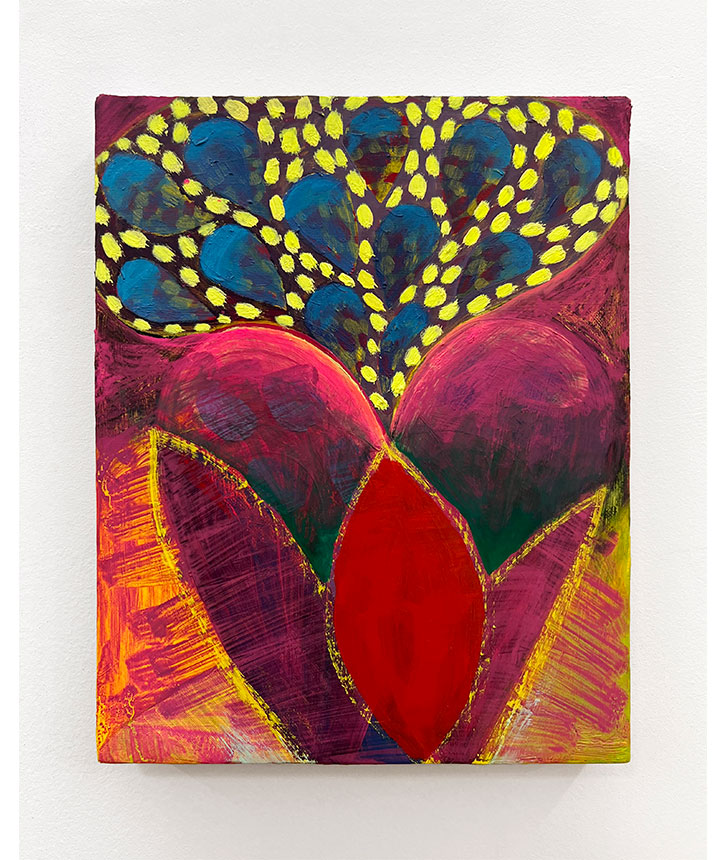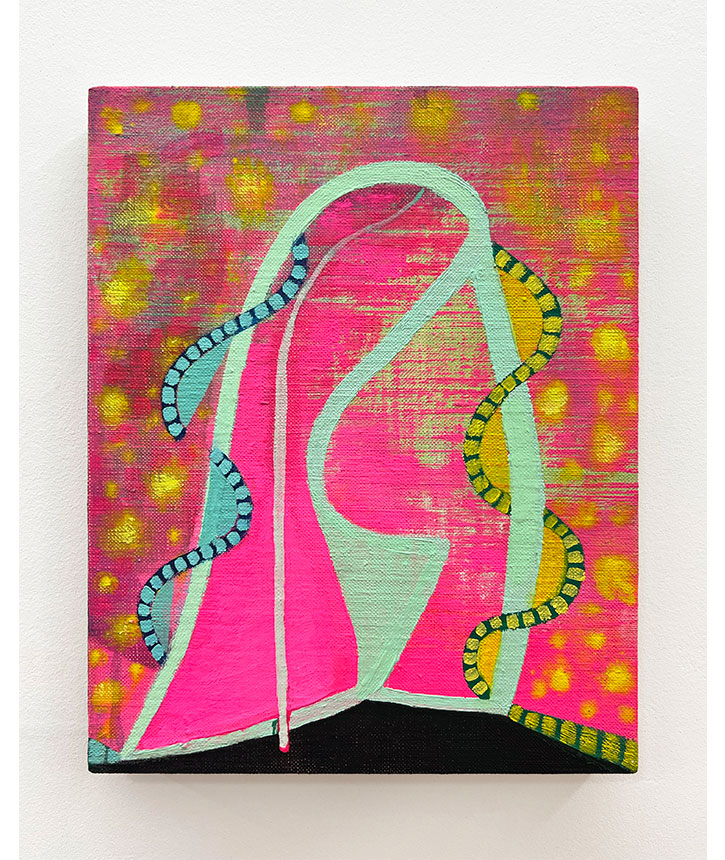Kate Sable
Morning Letters
September 21 – November 2
Kate Sable (b. 1984 Blacksburg, VA) is a process-led abstract painter who
lives and works in the Washington, DC area. She holds an MFA from
American University and BFA from Virginia Tech. Recent solo exhibitions
include New River at Pazo Fine Art (Washington, D.C.), The Line as Folding at Virginia Tech’s Armory Gallery and Could I Have Been Just Anyone at Pazo
Fine Art (Kensington, MD). Recent group exhibitions include Not in Love with
the Modern World at Dickinson College (PA), DREAM JOURNAL curated by
Alex Ebstein at Goucher College (MD), Invocations at The Silva Gallery
(Washington, D.C.), as well as group shows at Circle Contemporary (IL),
Equilateral Gallery (LA), Left Field Gallery (CA), and Dutoit Gallery (OH). Her
work has been featured in multiple editions of Art Maze Mag and has also
been featured in Friend of the Artist. She has been interviewed for The
American Scholar and Inertia Studio Visits, and the podcasts I Like Your
Work and Beware the Artist. Her work has been reviewed in The Washington Post, Washington City Paper, and Two Coats of Paint.
“My painting practice is deeply rooted in the materials and physical act of
painting. Through undulating curves, lush paint handling, and an intuitive
approach to image construction, I like to generate a teetering sense of
movement and balance within the rectangle. Process-led abstraction offers
a churning flow of images and ideas for me, whereas an unpredictable process yields work that always feels freshly made, energetic, and ever-new. A painting becomes an interesting object to me after I’ve spent the time responding and reacting to the surface, navigating tensions between analytical and intuitive decisions, drawing lines between viscera and décor, while interjecting problems that I may be able to respond to, and work around. I want a painting to be loaded with jokes, clunky shapes, and a shifting figure-ground relationship, but also to find its own idiosyncratic resolve– becoming something that exists purely as the thing itself.”
–Kate Sable, 2023

When I lost my father unexpectedly last year, my studio was the only space I could go to really sit deeply in my grief. I was getting very little sleep, so I’d retreat to the studio at sunrise, before the rest of my family would wake for the day. Because my dad had recently helped me build out my studio, it was easily the place I felt closest to him; it was the last place we’d shared a significant amount of time together, installing lighting, finishing drywall, and preparing the walls. Painting felt impossible at the time, and I began writing letters to my father in these early morning retreats to the studio. While I gave myself permission to take a pause on painting, writing in my studio was instrumental in helping me move through the huge void created in his absence, while also continuing to activate the space with energy and dialog. The ritualistic nature of writing these letters helped me feel like I was still “doing something” in the studio, and eventually, after months of this practice, I very naturally came back to painting with a new sense of honesty and urgency. Although the process of writing and centering my grief in the studio was extremely draining, eventually, these little paintings replaced my need to write to him. These works became Morning Letters.
I think a lot about how I approach the editing and selection process when I’m working on a show, and Morning Letters was no exception. I had made a lot of small works leading up to the installation that were up for consideration, and it’s always been important to me that I allow myself to take risks in this selection process. I naturally wanted to narrow down my selection to the strongest of the paintings, but I also knew it was just as important to include works that made me feel a little uncomfortable—paintings that stir things up, and create an interesting discord to otherwise pleasant pairings. I get the most out of a show when I’ve stretched myself a bit– not striving for an idea that comes together in a tidy way, but rather, finding something that pushes my work into a new arena where I can see the paintings in a new way. Letting go a little and taking risks in the selection process to see what kind of tensions or elegant conversations can happen between paintings that weren’t necessarily relating to each other in the studio is such a treat. Morning Letters is full of little surprises like that.
The works in this show were particularly difficult to title. The exercise of titling paintings usually comes very easily to me. In Morning Letters, the titles are pulled from excerpts from the letters I wrote to my father after his death. I knew it would be a difficult exercise to go back and mine my own words during periods of deep grief and trauma, but it was a far more grueling and out of body experience than expected. It turns out that reading months of free association writing with the goal of finding little magical ideas or phrases that communicate the mundane, the insane, or maniacal thoughts racing in my mind was less cathartic, and instead exhibited very tangibly the actual roller coaster ride I’d been on. At times it felt like I was reading someone else’s words, which was a heartbreaking experience, but a process that yielded connectivity that brought me back to myself. It was an emotionally laborious challenge, but an important and valuable exercise in seeing the ups and downs that happen when grieving an immense loss.
I’ve never considered myself someone who works in series, but I approached this particular show quite differently. I’d began thinking about the concept of Morning Letters as a show almost immediately after we had our first studio visit and because of that, I see these paintings very much as a body of work deeply related to each other.
The process begins with making surfaces, which is a meditative and ritualistic practice for me, and I try to be intentionally present during the first steps of making a painting. When I started building the surfaces for the works in Morning Letters, the ideas very urgently revealed themselves. By the time I had built a handful of surfaces, stretched or covered in linen, sized, and primed with oil ground, I had worked myself into a steady relay between building some, then painting some, and building some more, all while the fresh starts began to resolve and fall into place. It’s a hopeful and invigorating part of my practice, a time when things feel very open, uncommitted and free.
I think a lot about the tensions that can be revealed as I’m working through a composition. I often find myself beginning with an ugly problem that I inevitably push around and wrestle with until it lands into a sort of idiosyncratic resolve that I like to feel both settled and a little uneasy or precarious. This play with tension motivates me a lot in the studio and keeps me fully engaged with my work. I joke that color is often secondary to me, but it’s mostly because I like to approach color in an intuitive way, so that I can continually challenge what I know about color relationships.
I like to allow the material and the process of fooling around with the stuff guide the development of my paintings, anywhere from the compositions to the final color sensibility. I prioritize discovery over any particular stylistic ideas or goals, and I always aim to surprise myself in the studio because I’m much less interested in painting when I approach it with a plan of action. I really don’t like to know what step is next. I get stuck in a painting or get stuck in my head when there’s no discovery, or when it becomes more about executing an idea. Engagement with the material really keeps me motivated, and it’s invigorating to embrace the chaos that comes along with being process-led.
I think about Rebecca Morris, Mary Heilmann, Joanne Greenbaum, and Elizabeth Murray a great deal. I also love reading interviews and listening to artists talk about their practice because it feels like such a generous act of love to share in this capacity. I’m endlessly inspired when I learn about what makes an artist dedicate their life to artmaking.

Leave No Trace 2024
10 x 8 in oil on linen covered panel

Your Fathers Map 2024
oil on linen 66 x 54 in

The Drifts are Deep before they Melt 2024
oil on linen 24 x 21 in

Only a Nights Sky Away 2024
oil on linen covered panel 10 x 8 in

With a C or a K 2024
oil on linen covered panel 10 x 8 in

Lets Lay in the Dead Grass 2024
oil on linen 20 x 18 in

Say it Dont Spray it 2024
oil on linen covered panel 10 x 8 in

Swell of a Guy 2024
oil on linen covered panel 10 x 8 in

Invitation for Giration 2024
oil on linen covered panel 10 x 8 in

